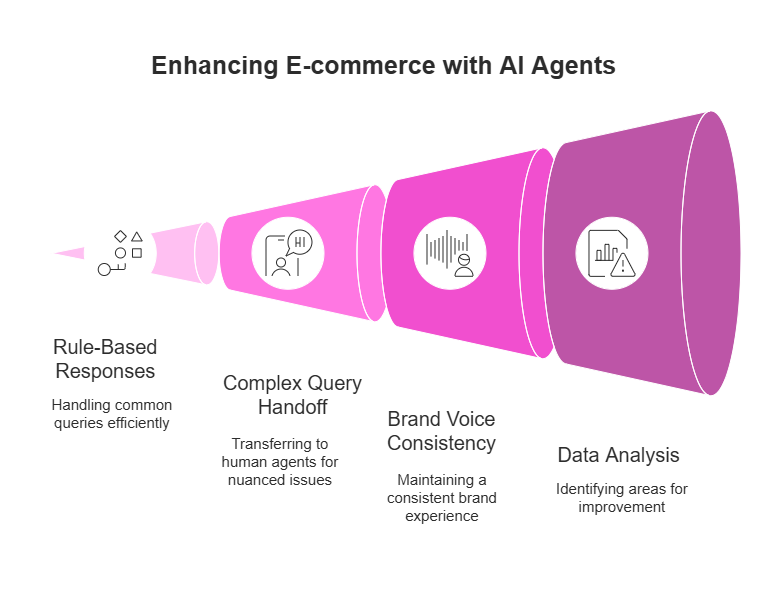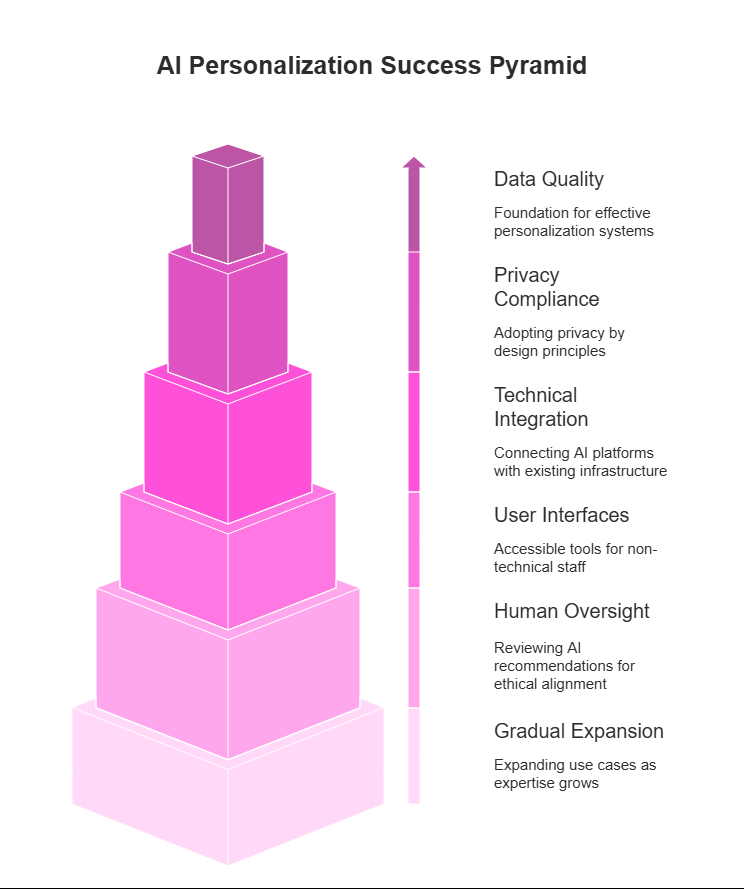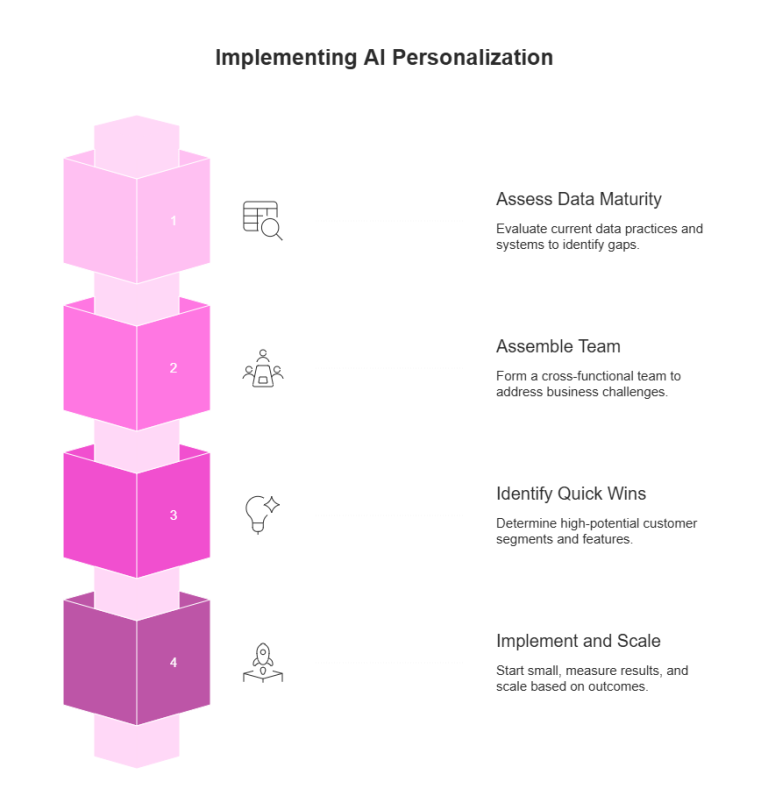This article explores how AI transforms e-commerce through personalized shopping experiences. Modern customers expect brands to recognize their preferences across all touchpoints. Companies implementing AI solutions see significant increases in engagement, conversion rates, and revenue.
The retail landscape has shifted toward smarter, more tailored experiences. This comprehensive guide provides the knowledge you need to stay competitive in an increasingly AI-driven marketplace. Whether you run a small online store or manage a large retail operation, these insights will help you create more meaningful connections with your customers.
Why Now Is the Time to Embrace AI in E-commerce
Online retail has transformed dramatically over the past few years. AI-powered shopping experiences have quickly shifted from futuristic concepts to essential business tools. Actually, 92% of businesses now use AI-driven tactics like dynamic pricing and voice search customization to remain relevant in today’s market.
Consumer expectations have fundamentally changed. Modern shoppers expect brands to recognize their preferences and anticipate needs across every touchpoint. Generic experiences and static promotional offers simply fall short of meeting these demands. In a way, customers now seek relationships with brands that understand them personally.
The competitive advantages are quite significant for businesses. AI reduces decision fatigue for customers through smarter recommendations. It naturally creates stronger emotional connections between shoppers and brands. Teams save approximately 6.4 hours weekly through improved operational efficiency. Higher conversion rates emerge through more relevant product suggestions.
Market projections confirm this urgency. AI-enabled e-commerce will reach $22.6 billion by 2032, growing at nearly 15% annually. Businesses must implement these technologies promptly to avoid falling behind competitors. Adopting AI personalization effectively represents the clear path forward for successful e-commerce operations.
Understanding AI-Driven Personalization in E-commerce
Have you noticed how online shopping experiences seem to know what you want before you do? Well, that’s AI-driven personalization at work. Traditional e-commerce once relied on basic rules—customers in segment X received offer Y. This approach sort of worked but couldn’t keep up with evolving expectations.
Modern machine learning systems analyze patterns differently. They don’t follow fixed paths. Instead, they continuously learn from browsing habits, purchase history, and contextual signals. These systems actually adapt with each interaction. Today’s recommendation engines use Retrieval-Augmented Generation technology for enhanced relevance. This approach combines creative AI capabilities with fresh data sources. The system parses product details, chunks descriptions, and queries databases to deliver spot-on suggestions.
These smart systems create real business wins:
- Shoppers find products faster, increasing satisfaction
- Customers develop stronger brand loyalty
- Average order values climb through intelligent suggestions
- Abandoned carts decrease significantly
McKinsey studies show companies using intelligent customization see revenue jumps of 15-20%. But honestly, the psychological benefit might be more valuable. Customers form emotional connections with brands that seem to understand them.
This creates, in a way, a positive loop: better suggestions drive more engagement, which generates richer data, making future recommendations even more accurate.
Types of AI-Powered Product Recommendation Systems
E-commerce platforms use several distinct recommendation approaches, each offering unique benefits for different business goals. Understanding these systems helps us select the right strategy for specific customer segments.
Collaborative filtering examines shopping patterns across our customer base. It identifies hidden connections between shoppers with similar tastes. Those familiar “Customers who bought this also purchased…” messages come from this approach.
Content-based models take a completely different path. These systems analyze product attributes like color, material, and price range. They match these characteristics with individual preferences based on past behaviors. In a way, this creates a personalized product profile for each visitor. The advantage? These approaches work well with new inventory where collaborative data might be limited.
For sophisticated personalization, context-aware methods incorporate situational factors into recommendations. These systems consider:
- Time of day or season
- Geographic location
- Device type
- Weather conditions
- Recent browsing history
These approaches power what industry experts now call cookieless marketing strategies. As third-party cookies disappear, brands increasingly rely on first-party behavior data. Real-time segmentation helps deliver relevant suggestions to shoppers.
The most effective platforms combine these approaches into hybrid systems. They leverage strengths from each method while minimizing limitations. This multi-faceted strategy ensures recommendations stay relevant regardless of available data points. Basically, the future of product recommendations lies in these intelligent combinations rather than single-method approaches.
Implementing AI Agents and Assistants for E-commerce
Virtual assistants transform browsing into interactive experiences, guiding shoppers through their buying journey while boosting engagement and conversion rates. These digital companions serve as the front line for customer service in modern online stores.
E-commerce platforms typically employ two types of AI agents. Simple Reflex AI Agents respond based on predetermined rules—when shoppers ask about return policies, these systems deliver answers using instant response logic. They handle common questions efficiently but struggle with unexpected queries or nuanced conversations.
For successful implementation, retailers should follow these practical guidelines:
- Focus on specific use cases rather than solving every shopper need
- Create seamless handoffs to human agents when conversations get complex
- Maintain brand voice consistency across all interaction channels
- Analyze conversation data to identify improvement opportunities
The integration works best when developers collaborate with service staff who understand shopper pain points. This partnership ensures virtual assistants address genuine needs rather than just showcasing technology.
Smaller retailers might start with rule-based systems handling basic tasks like order tracking. These focused applications create immediate value while building toward more sophisticated solutions that reduce shopping friction and strengthen buyer relationships.

Benefits of AI-Driven Personalization for E-commerce
The retail landscape has actually changed dramatically with smart personalization tools. E-commerce stores using these technologies see a 10–12% revenue increase on average. This boost matters significantly in an industry where profit margins often run thin.
Modern shoppers pretty much expect tailored experiences now. Research shows 58% Millennials expect personalization as standard practice. Meeting these expectations creates measurable wins:
- Conversion jumps of 15-35% with preference-based search results
- Cart abandonment drops of 20% through timely suggestions
- Average order values climb 25-40% via smart cross-selling
Beyond sales growth, these tools create operational advantages too:
- Marketing campaigns that optimize automatically
- Less manual work on customer segmentation
- Better inventory predictions that reduce overstock
- Lower acquisition costs as retention improves
Looking ahead, the future seems incredibly bright. AI solutions could boost profitability by 59% by 2035. This will happen as algorithms improve and more touchpoints become personalized.
These benefits grow over time, creating a positive feedback loop that separates AI adopters from traditional sellers.
Real-World Examples of Successful AI Personalization
Ready to see AI personalization in action? Let’s explore some impressive eight proven use cases from businesses that have mastered this technology. These AI examples showcase measurable results across various retail environments, from global enterprises to local shops.
Amazon serves as a benchmark for AI recommendation systems. Their suggestion engine actually contributes about 35% to overall sales revenue.
Beauty giant Sephora transformed shopping experiences with their Virtual Artist tool. This technology combines AI with augmented reality so customers can virtually sample makeup products. In a way, this innovation reduced returns by 30% while boosting conversion rates among users by half. Products traditionally requiring physical testing benefit most from this approach.
IKEA developed the Billie chatbot that handles approximately 50% of customer questions automatically. This AI solution frees human team members to tackle more complex issues. Customer service quality remains consistent regardless of time zone or hour.
These diverse case studies demonstrate that AI personalization delivers concrete advantages for companies of all sizes across various sectors.
Implementation Challenges and Solutions
Success with AI personalization requires overcoming several common hurdles. Businesses face technical, ethical, and operational challenges when implementing these powerful technologies.
Data quality forms the foundation for effective personalization systems. Poor or inconsistent information actually leads to flawed recommendations that damage customer trust.
Privacy concerns represent another significant challenge in personalization. Customers want tailored experiences but remain somewhat wary about how companies use their information. Successful implementations adopt privacy by design principles from the start. This approach includes collecting only necessary data, securing information appropriately, and providing transparent opt-out mechanisms.
Compliance with regulations like GDPR and CCPA must be built into systems rather than added later. In fact, Gartner predicts that by the end of 2025, 60% of large organizations will use AI to automate compliance processes, highlighting the growing importance of privacy-first approaches.
Technical integration often proves difficult, especially for companies with legacy systems. Solutions include implementing API integration tips that connect AI platforms with existing infrastructure. Starting with standalone modules before full integration helps minimize disruption. Many successful implementations also adopt scalable architectures that grow alongside business needs.
User-friendly interfaces for marketing teams are pretty important too. These interfaces allow non-technical staff to manage personalization without constant IT support. This accessibility ensures wider adoption across the organization.
Perhaps most crucial is maintaining human-in-the-loop oversight. AI systems excel at pattern recognition but lack contextual understanding and ethical judgment. Establishing processes where humans review recommendations ensures alignment with brand values and customer expectations. This balance between automation and human guidance prevents algorithmic biases from creating negative experiences.
Start with focused use cases and measure results rigorously. Expand gradually as your team builds expertise with these powerful tools. Patience during implementation pays off with more effective personalization and stronger customer relationships.

Measuring the Success of AI Personalization Efforts
How do you know if your AI customization efforts actually work? Well, measurement makes all the difference. The stakes remain incredibly high—studies reveal a 91% abandonment rate when shoppers encounter poor experiences. On the flip side, effective tailoring boosts order values by a staggering 98%.
A/B testing forms your optimization backbone. In a way, this scientific method replaces gut feelings with data-driven decisions.
Closing the feedback loop drives continuous improvement. Collect direct feedback through surveys, but also analyze implicit signals like hover time or click patterns. These insights help refine algorithms where customization falls short.
Measurement happens as an ongoing process, not a one-time event. Customer preferences shift, new products arrive, and competitors enhance their offerings. Weekly tactical checks and monthly strategic reviews ensure your tailoring efforts stay effective in this dynamic landscape.
Future Trends in AI-Driven Personalization
AI personalization keeps growing at an impressive pace. According to recent analysis, this sector will expand to $525.21B market size by 2025, with a 5.4% CAGR from $498.22B in 2024. Such growth reflects both tech advances and evolving shopper expectations.
The next phase in this evolution? Hyper-personalization. Unlike current methods grouping customers together, this approach treats each shopper as unique. Machine learning algorithms now analyze hundreds of data points instantly. This creates personalized experiences that adapt continuously. Research actually shows this level of customization can boost conversions by 150% while increasing revenue by 300%.
Generative AI changes product discovery through:
- Custom product descriptions tailored to individual shoppers
- Personalized visual content showing products in relevant contexts
- Conversational shopping experiences that feel genuinely human
Augmented reality will, in a way, take personalization further by letting customers visualize products in their own spaces before buying. Furniture retailers already see 40% higher conversion rates when shoppers use AR tools.
For businesses, the message seems clear: adopt scalable AI frameworks now. Companies that combine technological innovation with authentic human connection will build lasting customer relationships. AI works best when it enhances the personal touch rather than attempting to replace it.
Getting Started with AI Personalization in Your E-commerce Business
Wondering how to transform your e-commerce business with AI personalization? Well, the process starts with honest assessment and smart planning. Businesses following a structured approach actually achieve 64% efficiency gains while sidestepping expensive mistakes.
First off, evaluate your organization’s data maturity level. Successful personalization needs clean, accessible customer information from various touchpoints. Take a look at your current data practices, storage systems, and integration capabilities. Many organizations sort of discover gaps during this phase—fixing them early prevents headaches down the road.
Assembling a cross-functional team comes next. You might want to include representatives from:
- Marketing (understanding customer needs)
- IT (knowing technical infrastructure)
- Operations (implementing process changes)
- Leadership (providing direction)
This diverse group ensures your initiative tackles real business challenges instead of just chasing fancy technology.
To find your own quick wins, ask yourself:
- Which customer segments show the highest potential value?
- What features would most improve their experience?
- Where do analytics show friction in the purchase journey?
Balance immediate opportunities against strategic goals. Successful implementations typically start small, measure results, and scale based on proven outcomes. Each improvement builds on previous learnings, creating an ongoing cycle of enhancement.

FAQ
How do AI recommendation systems work?
AI recommendation systems use machine learning algorithms. These systems analyze user data to suggest relevant products. They forecast items a user is likely to buy. This enhances sales and improves customer experience.
What benefits can e-commerce businesses expect from personalization?
E-commerce businesses see increased conversion rates with AI personalization. Tailored experiences and dynamic pricing also help. It enhances customer satisfaction and increases revenue. Personalized recommendations contribute to increased engagement.
Which KPIs should I track for AI personalization?
Customer satisfaction score is a key performance indicator for AI personalization. Conversion rate is another important metric to consider. Customer lifetime value should also be tracked. These metrics measure the effectiveness of personalized experiences.
How do I choose the right AI tools for my store?
Focus on tools that integrate with existing platforms. Ensure chosen tools offer specific AI capabilities aligning with business needs. Select tools elevating business performance without disrupting established workflows. Prioritize tools enhancing performance and customer experience.



